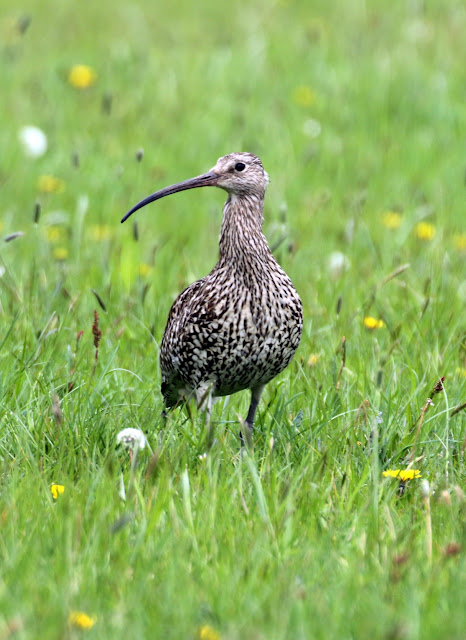During the spring Amanda Perkins, David Tompkins and I have been out talking to farmers and scouring the hills and fields of the Shropshire/Powys border looking for breeding Curlews as part of a 3 year HLF funded project run by the Stiperstones and Corndon Hill Landscape Partnership Scheme.
Building on last year and assisted by an army of volunteer Curlew surveyors from the local Community Wildlife Groups, co-ordinated by Leo Smith, we managed to locate approximately 40 pairs of territorial Curlews. This information then helped guide us to find a total of 21 nests, almost twice as many as in 2015.
Most nests were located in hay or silage fields
but some were in the more expected semi-improved or rough grassland
Most of these nests had surveillance cameras installed in an attempt to find out what was causing the nests to fail. Of the 21 nests located just three hatched a total of seven chicks and all seven chicks were known (or assumed) to be dead after less than a week. All seven chicks were fitted with small radio-tags whilst still in the nest. Two tags were recovered from under obvious perches indicating avian predation, one was recovered from under a hedge along with the metal leg-ring suggesting mammalian predation and one was the unfortunate victim of agricultural activity. Of the 18 failures at egg stage at least eight were due to foxes and at least three were due to badgers. One nest was trampled by sheep, another was trampled by cows and one nest was deserted, possible due to low and prolonged helicopter activity. The cause of failure at the remaining nests was not ascertained.
It is telling that at all three of the nests that hatched chicks we had installed electric fences, one from early on and two in the second half of incubation. It is our intention to fence far more nests next year in an attempt to increase the number of nests that progress to hatching.
Three nests were protected by three-strand electric fences
covering an area no less than 22m x 22m centred on the nest
It was a real ray of light in an otherwise frustrating and gloomy season that the farmers involved were so willing to engage with us in our attempts to monitor nests and to do what they could to help the Curlews succeed and our sincere thanks go to all of them.
Thanks to the agreement of the farmer the small area of un-cut grass in the middle of the field below the tractors held a Curlew nest that successfully hatched two chicks, although unfortunately both were subsequently predated.
To end on a slightly more positive note. During the spring another 40 odd Curlews were colour-ringed at the Montgomeryshire Wildlife Trust's Dolydd Hafren reserve. This brings the total ringed there in the last two years to 62. No fewer than eight of these birds were identified at local breeding sites, a brilliant result and something we hope to improve on in coming years. Two other Curlews, satellite tagged at Dolydd Hafren in March, were also tracked to breeding sites, one near Hay-on-Wye and the other on the Forest of Bowland!
The above map helped local RSPB Conservation advisor Gavin Thomas locate
the nest of this satellite-tagged female from Dolydd Hafren
It is very pleasing that we still have a Curlew population locally, albeit very reduced, but if these breeding results are widespread, and there is absolutely no reason to suggest otherwise, then we may not have them for much longer. Curlews, being so long-lived, naturally have a low reproductive rate but they still need to get some young away each year!!







When are people going to wake up and realise that predator control to help vulnerable species is vital. And how much benefit does ringing and tagging these birds actually have. Disturbing birds in the nest to ring and tag is ridiculous and more likely done for your own benefit and not the birds.
ReplyDeleteThe project has always considered that targeted, humane and legal predator control was always going to be an element of a successful solution to the decline of the Curlew - in lowland grasslands especially. Right from the outset we have been talking to the Game and Wildlife Conservation Trust on the most effective way to do this.
DeleteFar from being ridiculous, the tagging of chicks has been vital in demonstrating that the predation continues after the eggs have hatched and that the local population has virtually zero productivity. It is easy to assume, and difficult to demonstrate otherwise, that once the chicks leave the nest and walk off into the long grass they will be safe. None of the chicks tagged so far have been predated in the nest but have been picked off when they had left the nest and moved into shorter vegetation. The tagging has clearly demonstrated differing requirements for the actual nest site and for areas where the chicks go to feed.
We are constantly assessing our own activities and trying to minimise any consequences. If we thought we were having an adverse effect we would modify what we do otherwise our findings would be completely pointless.
Much work needs to be on predation control. As suggested by Sir John Lawton in the name of public benefit contrary to often mis-informed public opinion.
ReplyDeleteRob Yorke www.robyorke.co.uk
Perhaps the one that went to forest of Bowland has been reading the Raptor Persecution blog!!
ReplyDelete